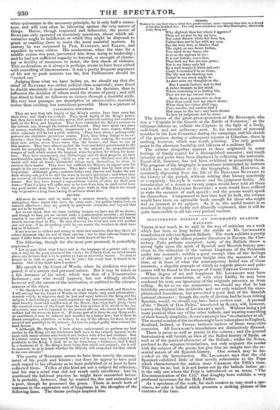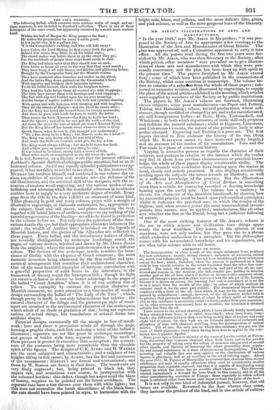ILLUSTRATED EDITION OP LOCKHART'S SPANISH B ALL ADS.
THERE is not much to be said in the way of criticism on a work which has been so long before the public as Mr. LOCKHART'S translation of selected Spanish Ballads. The work exhibits a pretty complete view of the oldest popular literature in Europe, the Can- terbury Tales perhaps excepted : many of the Ballads throw a strong light upon the spirit of Spanish and Moorish history pre* vious to the reduction of the various kingdoms of the Peninsula under one monarch ; exhibit a good enough idea of the feelings of chivalry ; and give a curious insight into the manners of the time, or at least of what the contemporary belief was of those manners ; a singular example of which as regards priests and prin- cesses will be found in the escape of Count FERISAN GONZALEZ.
What degree of art and happiness Mr. LOCKHART may have combined in the translation, or with what fidelity he may have rendered his text, our ignorance of the originals prevents us from telling. So far as we can conjecture, we should say that he has faithfully presented the incidents, and not only retained the unso- phisticated homeliness, but preserved a good deal of the Spanish national character ; though the style of diction, had he been writing Spanish, would, we should say, have had a modern cast. A perusal of the "Death of Don Pedro," translated by SCOTT, Will, however, convey the highest idea of LOCKHART'S merit. Without being a jot more poetical than any of the other ballads, and wanting something of their homely simplicity, Scores attempt has "no character at all." The mortal combat of the brothers might have taken place in England, Scotland, Ireland, or France, between natives of those respective countries. All LOCKHART'S translations are distinctively Spanish. There is prose as well as poetry in the volume ; and the general Introduction will furnish an idea of the Ballad history of Spain, as well as of the poetical character of the Ballads ; whilst the Notes, prefixed to the separate translations, not only acquaint the reader with the subject of the poem, but give him an insight into the es- sential nature of old Spanish history. One remark may be ha- zarded on the Introduction. Mr. LOCKHART says that the old Spaniard exhibited little of that servile submission to the Pope which characterized the nation since Casams the Fifth's time. This may be so, but it is not borne out by the ballads before us : in the only one where the Pope is introduced as an actor, "The Excommunication of the Cid," that doughty hero exhibits a very profound reverence for the Holy Father. As a specimen of the work, for such readers as may need a spe- cimen, we take a ballad which presents a striking picture of the customs of the time.
THE CM'S WEDDING.
The following ballad, which contains some carious traits of rough and an- tique manners, is not included in Escobar's collection. There is one of these descriptive of the same event, but apparently executed by a much more modern band. Within his hall of Burgos the King prepares the feast ; Be makes his preparation for many a noble guest. It is a joyful city, it is a gallant day, 'T is the Campeador's wedding, and who will bide away Layn Cairo, the Lord Bishop, he first comes forth the gate ; Behind him comes Ruy Diaz, in all his bridal state ; The crowd makes way before them as up the street they go; For the multitude of people their steps must needs be slow.
The King had taken order that they should rear an arch, From house to house all over, in the way that they must march; They have hung it all with lances, and shields, and glittering helms, Brought by the Campeador from out the Moorish realms.
They have scattered olive-branches and rushes on the street, And the ladies fling down garlands at the Campeador's feet ; With tapestry and broidery their balconies between, To do his bridal honour, their walls the burghers screen.
They lead the bulls before them all covered o'er with trappings ; The little boys pursue them with hootings and with clappings; The fool with cap and bladder upon his ass goes prancing, Amidst troops of captive maidens with bells and cymbals dancing.
With antics and with fooleries, with shouting and with laughter, They fill the streets of Burgos : and the Devil he comes after ; For the King has hired the horned fiend for twenty maravedis, And there he goes, with hoofs for toes, to terrify the ladies.
Then comes the bride Ximena—the King he holds her band ; And the Queen ; and all in fur and pall the nobles of the land. All down the street the ears of wheat are round Ximena flying; But the King lifts off her bosom sweet whatever there is lying.
Quoth Suero, when be saw it, (his thought you understand,) "'Tis a fine thing to be a King ; but Heaven make me a hand!" The King was very merry when be was told of this, And swore the bride ere eventide must give the boy a kiss.
The King went always talking ; but she held down her head, And seldom gave an answer to any thing he said: It was better to be silent, among such a crowd of folk, Than utter words so meaningless as she did when she spoke.
It is not, however, as a literary work that the present edition of Lockhart's Spanish Ballads challenges public attention, but as an il- lustrated volume. And if any equally splendid publications ever ap- peared, it has not fallen to our lot to see them. In this instance Mr. MURRAY* has outdone himself, and combined in one volume the va- rious capabilities of ancient and modern art—the richness of the old illuminators, and the artistical skill of the designer, with the re- sources of modern wood-engraving, and the various modes of em- bellishing and adorning which the wonderful advances in mechanics enables taste to supply to a very moderate degree of wealth. Every page from the title to the finis exhibits an ornament of some kind. Titles gleaming in gold and many colours, pages with a margin of illustrative engravings, or elaborate arabesques, &c., appropriate to the subject, head and tail pieces, and plates depicting the text, together with initial letters of endless variety—to say nothing of the tasteful gorgeousness of the binding—are all to be found in perfection in the volume before us. Not only does the splendour of the deco- rations dazzle the eye, but their appropriate character influences the mind : the wealth of Arabian fancy is lavished on the legends of Moorish history, and the glories of the Alhambra are reflected in these pages. Every ballad, and the introductory notices of them, are severally distinguished by arabesque borderings round the pages, of various devices, selected and drawn by Mr. OWEN JONES from the originals : where the same pattern recurs, it is in a different colour. The devices of the arabesque scrolls combine the luxu- riance of Gothic with the elegance of Greek ornament ; the most fantastic invention being chastened by the firm outline and sym- metrical arrangement that constitue their architectural character. One of the most beautiful examples of intricate convolution with a graceful proportion of solid forms to the interstices, is the framework of tracery round the letterpress title ; though its light yet massive richness is shown to better advantage in the pages of the ballad "Count Arnaldos," where it is of one uniform tint of yellow. To exemplify by contrast the peculiar character of Moorish ornament, we point attention to a vine-border of modern design surrounding the ballad of " The Lady of the Tree " ; which, though pretty in itself, is not only inharmonious but inferior : the natural character of the foliage and the picturesque style of treat- ment are unsuited to the architectural charaeter of the arabesques, which admit of no shade or gradation of tint ; being not represen- tations of actual things, but translations of natural forms into artificial shapes.
Pictorial designs occasionally fill the margin in lieu of scroll- work ; here and there a procession winds all through the page, forming a graphic chain, each link enclosing a verse of the ballad it illustrates ; vignettes are set like gems in arabesque mountings ; and groups of bolder style form separate plates. The merit of these pictures is greater in execution than conception ; the correct- ness of the costumes being more remarkable than the chivalric spirit of the figures. The designs of C. E. AUBRY and H. WARREN are the most animated and characteristic ; and a tailpiece of two knights tilting in full career, by AUBRY, has the fire and movement of the tournament • HARVEY'S are formal and conventional; and those by W. Sams are heavy in their force. The wood-cuts are very finely engraved ; but, being printed in black ink, they appear raw, and sometimes even coarse, in juxtaposition with the coloured borders : this defect, though but a spot amid the blaze of beauty, requires to be pointed out for future avoidance. The separate cuts have a tint thrown over them with white lights ; but this does not neutralize the harsh discordance of the black lines : the cuts should have been printed in sepia, to harmonize with the bright reds, blues, and yellows, and the more delicate lilac, green, and pink colours, as well as the more gorgeous hues of the blazonry.



























 Previous page
Previous page